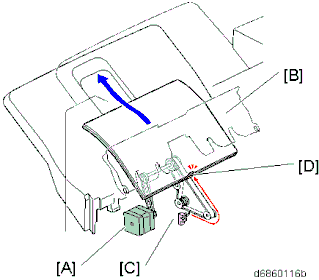HOME PAGE | < Previous | Contents | Next >
Booklet Finisher SR3220 / Finisher SR3210 (D3B9/D3B8)
Stapled paper eject mechanism
FINISHER SR3210/ BOOKLET FINISHER SR3220 (D3B8/D3B9)
FINISHER SR3210/ BOOKLET FINISHER SR3220 (D3B8/D3B9)
FINISHER SR3210/ BOOKLET FINISHER SR3220 (D3B8/D3B9)
Paper must first be stored in the stapler tray [A]. After the stapler tray paper surface sensor detects the paper sheet rear edge, the approach roller [C] descends, and transports the paper to the stapler tray.
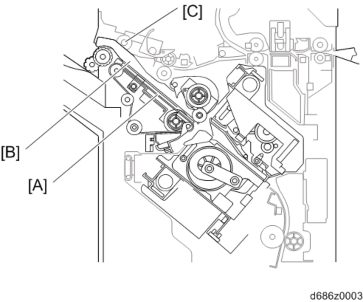
No. | Description | No. | Description |
[A] | Stapler tray | [C] | Approach roller |
[B] | Jogger fence |
Booklet Finisher SR3220 / Finisher SR3210 (D3B9/D3B8)
Stacking mechanism (approach roller operation)
The rear edges of the paper stacked in the stapler tray are aligned one sheet at a time.
The paper is transferred to the reverse roller [B] by the approach roller [A], driven by the positioning roller motor, after the intermediate transport (left) paper surface sensor turns OFF. The paper is then continuously pressed against the trailing edge fence by the reverse roller [B].
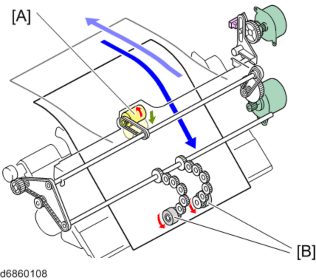
Trailing edge fence operation
The trailing edge fence used depends on the binding mode of the stapler. There are two trailing edge fences, upper and lower.
Upper trailing edge fence
Operated by the booklet transport (upper) pressure release motor.
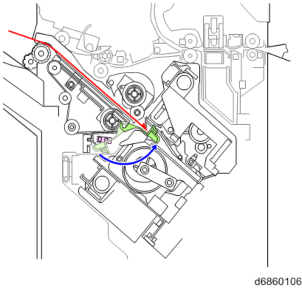
Binding modes: Edge binding mode (one position)/edge binding mode (two positions), and booklet stitch mode (small sizes: B5, A4, LT)
Booklet Finisher SR3220 / Finisher SR3210 (D3B9/D3B8)
Lower trailing edge fence
When the stapler moves to the center, the trailing edge fence is depressed by hitting the stapler.
FINISHER SR3210/ BOOKLET FINISHER SR3220 (D3B8/D3B9)
FINISHER SR3210/ BOOKLET FINISHER SR3220 (D3B8/D3B9)
FINISHER SR3210/ BOOKLET FINISHER SR3220 (D3B8/D3B9)
Binding modes: booklet stitch mode (large sizes: LG, B4, A3, DLT, 12"×17.7")
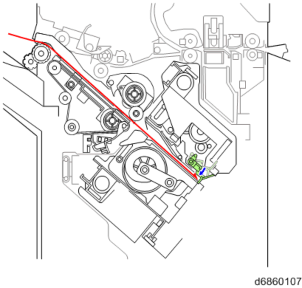
Jogger operation
After the paper rear edges have been aligned by stacking, jogger operation is then performed to align the width.
The jogger fences [B] are opened and closed by the jogger motor [A]. At the start of jogging, the jogger fences [B] stand by in a state where they are opened wider than the paper width. When the rear edge of the transported paper is pressed against the trailing edge fence by the reverse roller, the jogger fences move close to the edges of the paper.
Next, the jogger fences move to the edges, to align the paper.
After jogging is complete, the jogger fences again open, and stand by to receive the next sheet.
The home position of the jogger fences is detected by the jogger HP sensor [C].
Booklet Finisher SR3220 / Finisher SR3210 (D3B9/D3B8)
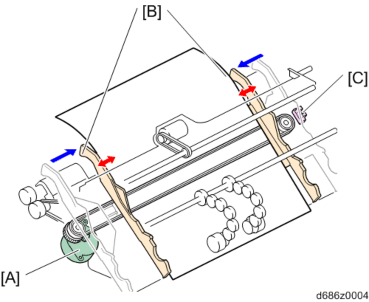
Paper exit guide plate open/close mechanism
When paper is stacked in the stapler tray, the paper exit guide plate [A] is opened to cancel the load on the paper exit roller.
When paper is stacked in the stapler tray, the paper exit guide plate remains open from the first page to the last page, and after the stapling operation is finished, the paper exit guide plate is closed, and the paper is ejected by the paper exit roller and release belt.
The switching action of the paper exit guide plate is driven by the paper exit guide plate open/close motor [B] via a link.
The home position of the paper exit guide plate is detected by the paper exit guide plate open/close HP sensor [C].
Booklet Finisher SR3220 / Finisher SR3210 (D3B9/D3B8)
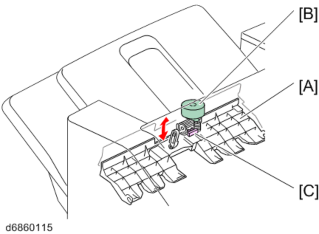
FINISHER SR3210/ BOOKLET FINISHER SR3220 (D3B8/D3B9)
FINISHER SR3210/ BOOKLET FINISHER SR3220 (D3B8/D3B9)
FINISHER SR3210/ BOOKLET FINISHER SR3220 (D3B8/D3B9)
Stapler displacement mechanism
The stapler unit [A] staples the stack of sheets.
The stapling position changes with the stapling mode and paper size.
When the operation starts after power is switched on, or the front door opens and closes, the main controller board drives the stapler transfer motor [B] to return the stapler unit to the home position.
The stapler unit starts to transfer the paper to the front side of the stapler frame, and when the stapler HP sensor [C] under the stapler unit detects the screen, it temporarily stops. Then, the stapler transfer motor is driven for a predetermined number of pulses. The stapler unit moves to the rear side, and stands by.
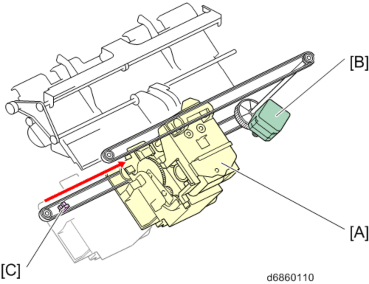
To prevent the stapler unit colliding with the feedout pawl and trailing edge fences, a stapler retreat sensor is provided.
Edge binding mode (one position):
Booklet Finisher SR3220 / Finisher SR3210 (D3B9/D3B8)
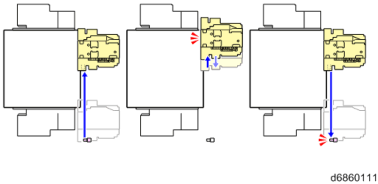
Edge binding mode (two positions):
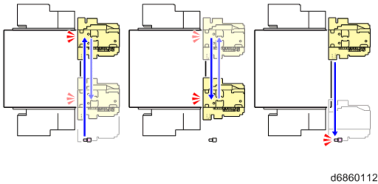
Booklet stitch mode (small sizes: B5, A4, LT):
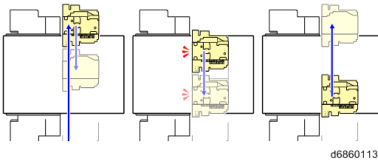
Booklet stitch mode (large sizes: LG, B4, A3, DLT, 12"×17.7"):
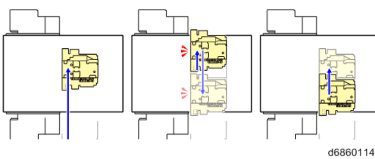
Booklet Finisher SR3220 / Finisher SR3210 (D3B9/D3B8)
Release mechanism
Paper exits to the shift tray by the feedout pawl and the paper exit roller after the stapling is done.
When the feedout pawl motor [A] turns ON, the release belt is driven and the paper is moved upwards by the feedout pawl [D].
FINISHER SR3210/ BOOKLET FINISHER SR3220 (D3B8/D3B9)
FINISHER SR3210/ BOOKLET FINISHER SR3220 (D3B8/D3B9)
FINISHER SR3210/ BOOKLET FINISHER SR3220 (D3B8/D3B9)
When the stapled stack touches the paper exit roller, the paper exit guide plate [B] closes and the paper is released. To prevent the stack from moving up too much, the feedout pawl motor is stopped temporarily.
The home position of the release belt is detected by the feedout pawl HP sensor [C].
